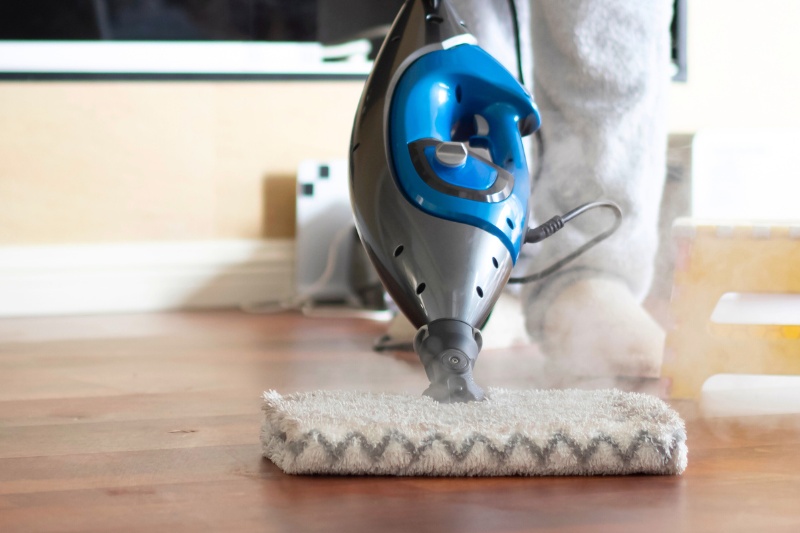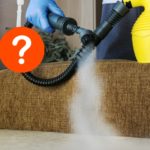Steam mops have revolutionised the way we approach floor care. They offer an efficient, eco-friendly, and chemical-free solution to the continuous battle against dirt and germs.
However, knowing how to use a steam mop correctly is crucial if you’re looking for spotless floors.
Here, we explain how you can harness the power of steam to clean the floors in your home.
How to Use a Steam Mop on Tiles
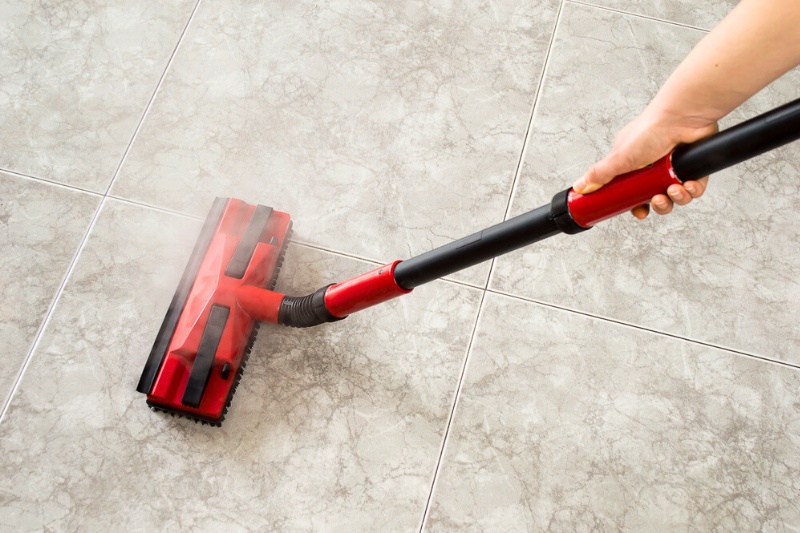
Steam mops are designed primarily for hard surfaces like tiles, making them an excellent option for easy and effective cleaning.
Using a steam mop on a tiled floor is also a great way to clean and sanitise your bathroom or kitchen without the use of harsh chemicals.
Here’s a step-by-step guide on how to use a steam mop on tiles the right way:
- Sweep or vacuum: Remove loose dirt and debris from the tiled floor by sweeping or vacuuming. This step prevents the mop from pushing dirt around and helps achieve a more thorough clean.
- Prepare the steam mop: Fill the water reservoir of the steam mop with clean water, making sure not to overfill it. Then, plug the mop into an outlet and turn it on. Leave it for a few minutes for the water inside them to heat up to high enough temperatures to produce steam.
- Select the steam setting: Choose an appropriate steam setting for the floor and level of dirt you’re dealing with. Lower settings should be used on more delicate tiles, whereas higher settings are better for more robust or dirtier floors.
- Start mopping: Begin mopping by slowly pushing the steam mop over the tiles, using either a back-and-forth or side-to-side motion. Be sure to cover the entire area evenly, but avoid letting the steam linger in one spot for too long, especially if your tiles are sensitive to heat.
- Clean the grout lines: Steam is effective at cleaning grout between tiles, as well as the tiles themselves. Put on a separate attachment or nozzle provided by your steam mop, then run the mop along the grout to remove dirt and grime.
- Leave the floor to dry: After steam-mopping the entire floor, allow it to air dry. The heat from the steam will help speed up the drying process, but it’s essential to let the tiles completely dry before walking on them.
How to Use a Steam Mop on Carpets
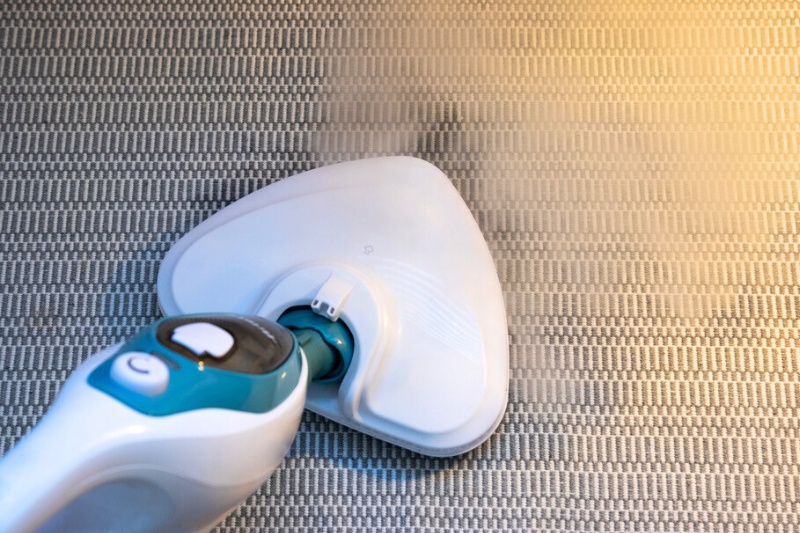
Carpets and rugs are porous and can trap moisture from steam, potentially causing problems like mould and mildew growth, carpet damage, and even voiding warranties.
Therefore, we don’t recommend using a steam mop on carpets. It’s better to use a carpet cleaner or steam cleaner specifically designed for this purpose.
However, you can use a steam mop on a carpet if you really want to. Make sure you test on an inconspicuous area of the carpet before mopping the whole floor to ensure it doesn’t cause any damage or distortion.
Then, follow the steps below:
- Sweep or vacuum: Before using your stream mop, vacuum the carpet to remove any loose dirt and debris. Leaving dirt on the carpet when steam cleaning causes it to spread, so removing it before ensures a more effective clean.
- Pre-treat carpet stains: If there are stains on the carpet – be it ink stains, cat pee stains, playdough, or any other marks – you may want to pre-treat them with a stain remover. Allow the stain remover to sit for the recommended time before proceeding.
- Turn on the steam mop: Fill the mop reservoir with water and turn it on by plugging it into a power outlet and flicking the “on” switch. You’ll want to leave it plugged in for several minutes before beginning to mop—this allows the water to heat up so that it can produce steam.
- Start mopping: Choose an appropriate attachment for carpets, then start mopping your floor. Start in the far corner of the room and work towards the door. We recommend working in straight lines to ensure you don’t miss any of the fibres.
- Leave the carpet to dry: After cleaning, let the carpet dry completely. You can speed up the drying process by opening windows, using fans, or running a dehumidifier. Then, vacuum the carpet again to fluff up the fibres and remove any remaining loose dirt.
Why Is My Floor Still Dirty After I Steam Mop?
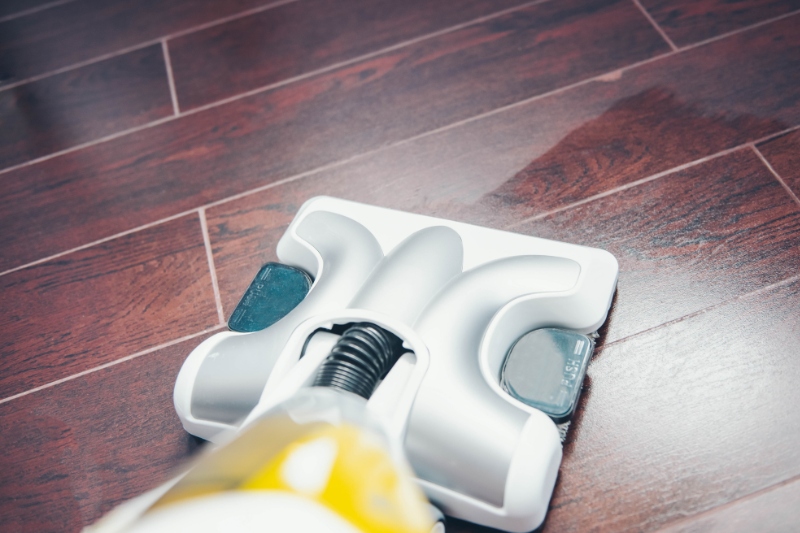
Your floor might be dirty after steam mopping for several reasons, usually due to incorrect cleaning techniques—make sure to follow the steps above for the best results.
If you’re still experiencing issues, here are some common reasons and troubleshooting tips to help you achieve a cleaner result:
- Insufficient pre-cleaning: Steam mops are most effective on surfaces that are already relatively clean. Ensure you’ve swept or vacuumed the floor to remove loose dirt and debris before using the steam mop.
- Steam mop temperature: Some steam mops have adjustable steam settings. If your mop is set to a low steam output, it may not provide enough heat and moisture to clean tough stains or grime effectively. Try using a higher steam setting for challenging areas.
- Dirty mop pad: If your mop pad is dirty or worn out, it won’t pick up dirt and grime from the floor effectively. Ensure your mop pad is clean and in good condition, or replace it if necessary.
- Hard water deposits: If you have hard water in your area, mineral deposits can build up in the mop’s heating element and steam nozzles, reducing its cleaning effectiveness. Periodically descale your steam mop as recommended by the manufacturer.
- Overly soiled floors: Steam mops are best suited for regular maintenance cleaning. If your floor is heavily soiled, a steam mop may not be sufficient. In such cases, consider other cleaning methods, such as spot cleaning or using a regular mop.
- Improper technique: Make sure you are using the steam mop correctly by moving it at a slow and steady pace. Avoid leaving the mop in one spot too long, as this can saturate the floor and potentially damage it. You may need to go over areas multiple times.
If you’ve tried these troubleshooting tips and your steam mop is still not effectively cleaning your floors, your mop may need maintenance or repair.
Refer to the instructions or contact their customer support for further assistance or recommendations.
Can You Use a Steam Mop Without Water?
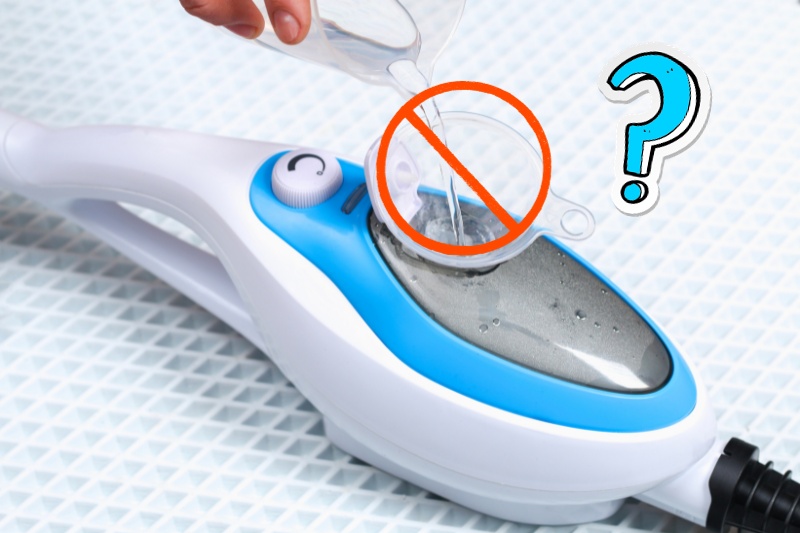
You should not use a steam mop without water. Using the steam mop as intended with water is essential for effective cleaning.
They are designed to generate steam by heating water in a reservoir, and the steam is the primary cleaning agent that helps sanitise and clean your floors.
Attempting to use a steam mop without water can result in several issues:
- Running a steam mop without water can overheat the heating element, potentially causing damage to the mop and rendering it inoperable.
- Without steam, the mop will not effectively clean or sanitise your floors. Water is necessary to produce the hot vapour that loosens dirt and grime for removal.
- Operating a steam mop without water can create a safety hazard due to the risk of overheating and potentially causing a fire or damaging the internal components.
Always follow the instructions for your specific steam mop model, outlining the proper use and maintenance procedures. This includes the correct way to fill and empty the water reservoir.
Steam Mop vs Regular Mop
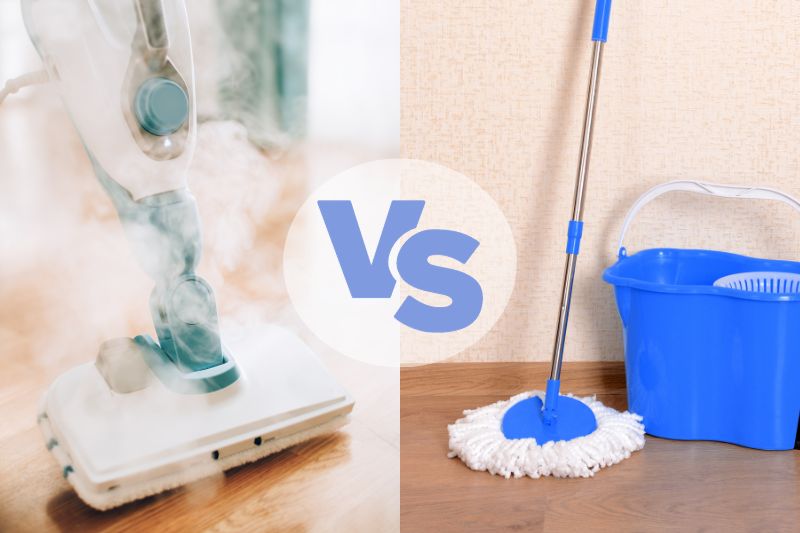
Steam mops and regular mops are both used for floor cleaning, but they have significant differences in terms of cleaning methods, features, and effectiveness.
Here’s a comparison of the two to help you decide which is the best option for mopping floors:
Cleaning method
- Steam mop: Steam mops use hot steam to sanitise floors. They have a built-in water reservoir that heats the water to produce steam, which is then applied to the floor through a mop head or nozzle. The steam helps to loosen dirt and grime, making it easier to remove.
- Regular mop: Regular mops, also known as traditional or conventional mops, rely on a combination of water and cleaning solution (often a floor cleaner) applied to a mop head or cloth. The mop is manually wrung out to remove excess liquid, and then the damp mop is used to clean the floor.
Cleaning effectiveness
- Steam mop: Steam mops are known for their ability to effectively sanitise and clean floors without the need for chemicals. The high-temperature steam can kill many types of bacteria and germs, making them a popular choice for households with allergies or concerns about chemical exposure. They are particularly effective on hard, sealed surfaces.
- Regular mop: Regular mops rely on the cleaning solution and physical agitation to clean the floor. While they can be effective, their cleaning performance depends on the quality of the cleaning solution and how much effort you put in.
Convenience and ease of use
- Steam mop: Steam mops are generally considered more convenient because they eliminate the need for a separate bucket of water and cleaning solution. They are ready to use quickly, and the steam dries faster than traditional mop water.
- Regular mop: Using a regular mop involves more manual effort, including filling and carrying a bucket of water and wringing out the mop head as needed. It can be more time-consuming and physically demanding.

Maintenance
- Steam mop: Steam mops require regular maintenance, such as descaling to prevent mineral buildup in the heating element and replacing or cleaning mop pads. They may also need periodic filter replacements.
- Regular mop: Traditional mops are relatively simple and have fewer maintenance requirements. You’ll need to wash and replace mop heads as they become worn or dirty.
Floor types
- Steam mop: Steam mops are best suited for hard, sealed surfaces like tile and hardwood. However, they should not be used on unsealed wood or other sensitive flooring types. For example, you shouldn’t use a steam mop on Karndean flooring or laminate floors, which are sensitive to moisture and humidity.
- Regular mop: Traditional mops are versatile and can be used on a wider range of floor types. This includes both hard surfaces – such as stone, concrete, tiles, and hardwood – and some soft surfaces like vinyl, certain types of carpet, and laminate.

Hannah has a passion for cleaning. She worked her way around Australia by cleaning hostels in exchange for free accommodation and used her cleaning skills to bag a job as a chalet host for a luxury ski company in France.
